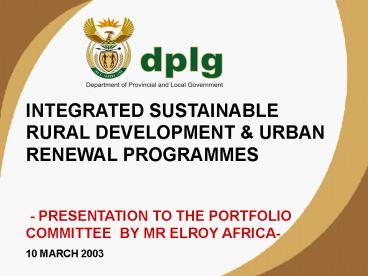EEHCStrategy - PowerPoint PPT Presentation
Title:
EEHCStrategy
Description:
JANUARY 2001: Appointment of DPLG as a co-ordinating Ministry / Department for the ISRDP ... Many nodal municipalities historically weak and incapacitated ... – PowerPoint PPT presentation
Number of Views:44
Avg rating:3.0/5.0
Title: EEHCStrategy
1
INTEGRATED SUSTAINABLE RURAL DEVELOPMENT URBAN
RENEWAL PROGRAMMES - PRESENTATION TO THE
PORTFOLIO COMMITTEE BY MR ELROY AFRICA- 10 MARCH
2003
2
PRESENTATION OUTLINE
- Background
- Key Objectives Principles
- Progress since 2001
- Lessons Challenges
- Priorities for 2003/4
1
3
INTRODUCTION AND BACKGROUND
- JANUARY 2001 Appointment of DPLG as a
co-ordinating Ministry / Department for the ISRDP - FEBRUARY 2001 Announcement of 21 rural and urban
nodes by the State President - Exploring additional rural nodes for 2003
4
RURAL NODES
5
URBAN NODES
6
Key Objectives
- To mount a sustained attack on poverty and
under-development - To champion, spearhead and showcase sustainable
development in the 21 nodes (13 rural 8 urban) - To pioneer innovative modes of planning,
budgeting, delivery and governance - Demonstrate new vision of developmental local
government
7
PRINCIPLES
- Poverty targeting and alleviation
- Local economic development
- Improved coordination and integration across
government - Decentralisation of decision-making
- Demand-driven approach
- Partnerships
- Community participation
8
CONTEXT
- Progress with implementation must be measured
- against various contextual factors
- Roll-out of programmes coincided with the
establishment of the new local government system - Many nodal municipalities historically weak and
incapacitated - Provinces have struggled to define their support
role
9
PROGRESS SINCE 2001
- Both programmes are in the delivery/
implementation phase - Specific achievements
- All nodes have adopted IDPs
- PIMS Centres established in all 13 rural nodes
- IDT support structures in place for the ISRDP
- R65m provided for ISRDP institutional development
project initiation - Political champions in place for all nodes
guidelines developed - The anchor projects are having a positive impact
and will create conditions for local economic
development
10
Progress on ISRDP Projects
- 260 anchor projects identified (increased from
137) - 60 are in the implementation phase
- 68 of projects in the infrastructure category
- R1.7bn committed to rural nodes, while R960m
committed to anchor projects (2002/3) - Various SMMEs are being supported
11
Progress on URP Projects
- 90 anchor projects identified nationally, which
focus mainly on infrastructure development - R2.1bn committed to urban nodal municipalities
(2002/3)
12
MAIN LESSONS
- There were a number of lessons which should be
taken on board during programming. These mainly
centre around the poor co-ordination between
spheres of government - The IDPs and PGDSs not aligned in some
provinces the PGDS is not adequately formulated
and updated. - Inconsistent planning and budgeting, resulting in
some nodes not being able to access funds. - At the same time, some projects received funds
but did not have adequate capacity to utilise
them effectively. - Projects being implemented by some national
departments not addressing the priority needs at
local level.
5
13
GAPS CHALLENGES
- Enhance predicability in resource allocation from
national and provincial government - Increase visible political championship
- Improve local capacity and reduce dependency on
national provincial government - Investing in appropriate infrastructure to enable
and facilitate economic development
14
FOUR PRIORITIES FOR 2003/4
- 1. Community Development Workers at local level.
- 2. Skills Development Programme in nodes.
- 3. Support Key Anchor Projects.
- 4. Align and Consolidate IDPs and PGDSs.
6
15
INTERVENTIONS IN RURAL AND URBAN NODES 2003
7
16
INTERVENTIONS IN RURAL AND URBAN NODES 2003
8
17
INTERVENTIONS IN RURAL AND URBAN NODES 2003
8
18
INTERVENTIONS IN RURAL AND URBAN NODES 2003
10
19
INTERVENTIONS IN RURAL AND URBAN NODES 2003
11
20
INTERVENTIONS IN RURAL AND URBAN NODES 2003
12
21
INTERVENTIONS IN RURAL AND URBAN NODES 2003
13
22
INTERVENTIONS IN RURAL AND URBAN NODES 2003
In conclusion, the 2003 Programme of Action will
be characterised by (1) Deeper community
participation (2) Focus on skills
development (3) Major anchor projects and (4)
An improved integrated planning and
implementation framework. The Report to Cabinet
will be submitted in July 2003.
14


















